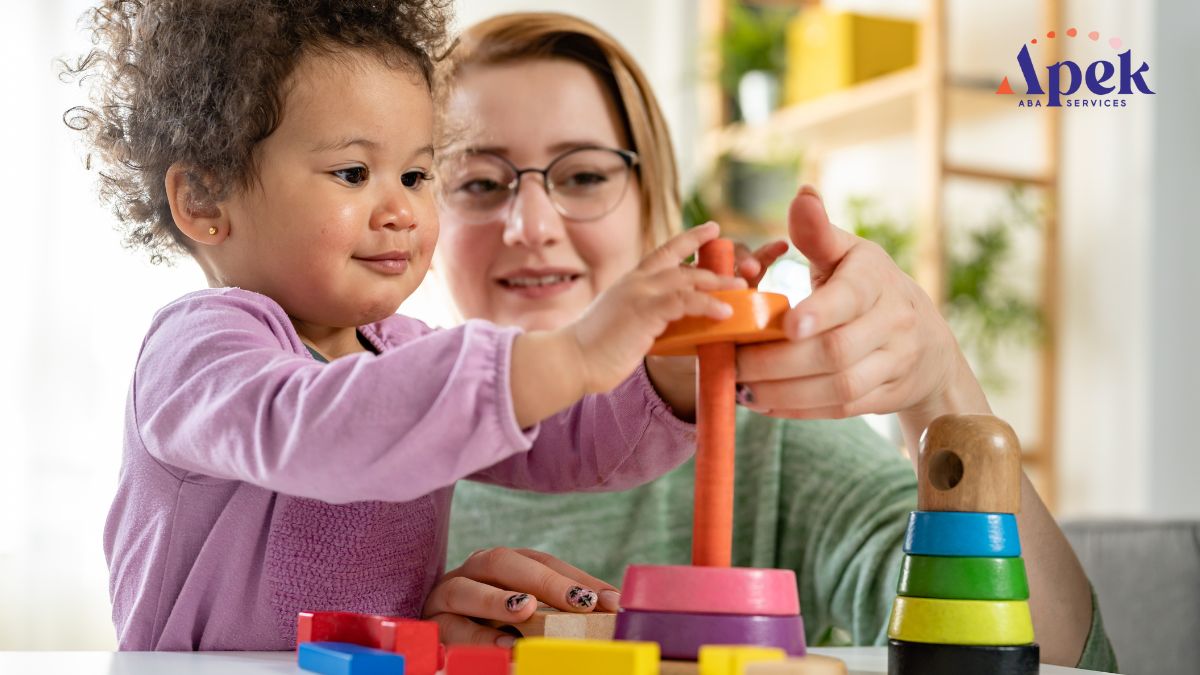Key Points:
- Play therapy for autism helps children build joint attention, communication, flexibility, and social engagement by embedding goals inside natural play.
- Models like DIR/Floortime, NDBI, PRT, and JASPER use child-led routines, prompting, and reinforcement.
- Families see the most progress when therapy targets are repeated at home, school, and daily routines with caregiver coaching.
Meltdowns during transitions, limited back-and-forth play, and rigid routines can wear down a day fast. Play therapy for autism meets children in a space that feels safe and familiar. The focus lands on shared joy first, then communication and problem-solving.
Expect practical strategies you can use today, from choosing play setups to coaching turn-taking. By the end, you will know the main benefits, proven techniques, and step-by-step tips to make sessions work at home and in clinic.
What Is Play Therapy and How Does It Help?
Play therapy creates a structured way to learn through toys, pretend scenes, movement, and turn-taking. For autistic children, play becomes the doorway to joint attention, imitation, and language. Sessions stay child-led when possible. Adults follow the child’s interests and load in targets like requesting, waiting, or shifting between activities.
Play therapy sits on a spectrum. Some models feel non-directive and focus on relationship and regulation. Others embed clear goals, prompts, and reinforcement inside natural play. Many teams blend both, so sessions feel fun while still building measurable skills.
A CDC update estimated that about 1 in 31 8-year-olds were identified with autism in 2022 across monitored U.S. communities, which keeps the need for practical, play-based supports front and center.
What to expect in a session
- A short warm-up that joins the child’s current interest.
- A shared play routine with clear roles, such as “you drive, I load,” often pairs with ABA communication targets like requests and short comments
- Gentle model prompts and visual cues to guide new responses.
- Brief data notes so progress stays visible without interrupting play.
Which Benefits Can Families Expect?
Play therapy leads with connection. Shared routines open the door to language and flexible behavior. Gains often start small and then show up in daily life once routines repeat across settings.
Common benefits
- Communication improves as children learn to request, comment, and respond in play.
- Social engagement grows as children tolerate turns, eye gaze, and simple role play, aligning with ABA social skills training.
- Flexibility increases as children accept small changes to rules, order, or materials.
- Regulation improves as children learn to pause, wait, and return to play after a block.
A meta-analysis of parent-mediated, play-based programs reported medium gains in social communication (d ≈ 0.63) and smaller gains in language (d ≈ 0.40). The same review saw modest reductions in autistic characteristics (d ≈ −0.19).
How benefits carry over
- Families reuse the same games during meals, bath time, and outings, a carryover approach detailed in parent-coached home routines.
- Teachers adapt the routine to centers or small-group time.
- Clinicians track the same targets across home and clinic to keep focus tight.
Which Play Therapy Models Are Used Most?
Several evidence-based approaches fall under play therapy in autism. Teams often mix them to match goals, age, and learning style.
Play-based therapy for autism: Core models
- DIR/Floortime. Child-led play that targets shared attention, engagement, and regulation.
- NDBI programs. Naturalistic Developmental Behavioral Interventions blend developmental goals with behavioral teaching in play.
- PRT. Pivotal Response Treatment targets motivation, responding to multiple cues, and self-management in natural activities.
- JASPER. Joint Attention, Symbolic Play, Engagement, and Regulation uses play to grow joint attention and symbolic play.
- Child-Centered Play Therapy. Non-directive sessions build relationship, safety, and expression through play.
Naturalistic, play-based methods show consistent gains across language, play, and social communication in young children, with the largest effects on directly taught skills.
How to choose a model
- Goals guide the pick. Joint attention needs often point to JASPER.
- Age and tolerance guide structure. Younger children may need shorter, highly engaging bursts.
- Parent capacity guides format. Parent-coached programs fit busy schedules and carry skills into daily life.

Play Therapy for Autism: What Does a Session Look Like?
Play therapy for autism sessions follow a repeatable arc. The routine keeps things predictable while still leaving room for creativity and child choice.
A simple session arc
- Connect. Join the child’s activity and mirror a few actions to build momentum.
- Stretch. Add one small change, like a pause for a request or a new prop.
- Practice. Repeat the new skill across two or three short games.
- Cool-down. End on a win with a familiar, easy routine.
Targets that work well in play
- Joint attention. Pointing, showing, and shifting gaze from object to adult.
- Language. Requests, labels, and simple two-word comments in context.
- Social rules. Waiting, turn-taking, and accepting a small change in order.
- Imitation. Copying actions with objects and later copying sounds or words.
- Symbolic play. Feeding dolls, building scenes, and acting out short stories.
Simple tools to keep handy
- Bubbles, wind-up toys, vehicles, pretend food, blocks, and figures.
- Visual cards for “my turn,” “your turn,” and “all done.”
- A small first-then board and a timer to mark short efforts.

How Often Should Sessions Run and For How Long?
Intensity depends on age, goals, and team capacity. Many families start with shorter sessions several times per week and build up as routines become familiar.
AAP guidance has long emphasized access to at least 25 hours per week of comprehensive intervention for children with ASD, especially in early years, which can include play-based programs delivered across settings.
Practical scheduling tips
- Start with 30 to 60 minutes, three to five times per week, and adjust as tolerance grows.
- Mix settings. Short home sessions plus preschool carryover build repetition.
- Protect one coaching slot for parents to learn and practice each week.
Signs the dose is right
- The child joins predictable routines without heavy prompting.
- Targets show up in daily life, not just in the therapy room.
- Parents can run a short routine solo and see a clear response.
Home Setup and Parent Coaching That Work
Autism play therapy thrives when home routines support the same goals between sessions. A few tweaks can strengthen attention and reduce friction.
Setup moves
- Use a small, low-clutter space with a neutral backdrop.
- Keep two bins: high-interest items for engagement and “work” items for targets.
- Add a floor mat or taped square to signal “play time” and a clear end.
Parent coaching moves
- Narrate short, concrete language that matches play.
- Wait a beat before giving prompts to allow spontaneous responses.
- Praise specific efforts. Say “nice asking for more blocks” instead of a generic “good job.”
Carryover ideas
- Turn dressing and meals into two-step games with simple roles.
- Use “first-then” cards for clean-up and transitions.
- Rehearse one change each day, like swapping the driver in a car game.

Finding Services Fast
Search terms can feel confusing when services overlap. Use clear phrases when you look for “play therapy for autism near me” and sort results by model and setting.
Many clinics list NDBI, JASPER, or PRT under broader terms like “autism play therapy” or “play therapy in autism.” Ask about caregiver coaching, goal tracking, and how play targets align with school IEP goals.
Questions to ask providers
- Which play models do you use and why for my child’s goals?
- How will you coach me to run routines at home?
- How do you measure progress and update targets?
Telehealth can work for coaching sessions and for short play bursts. Families can learn strategies on video, then practice off-camera and report wins and hurdles the next week.
Play Therapy vs Play-Based ABA: What Is the Difference?
Play therapy and play-based ABA share a lot of ground. Both rely on motivation, shared routines, and stepwise teaching inside natural activities. The main differences sit in structure and language.
Where they overlap
- Child interests drive activities and materials.
- Targets live inside play, not as isolated drills.
- Adults coach turn-taking, language, and flexibility with natural reinforcement.
Where they differ
- Play therapy may lean non-directive, with more emphasis on relationship and expression.
- Play-based ABA uses clear goal lists, data, and systematic prompting inside play, consistent with what is ABA therapy.
- Many teams blend both to match needs and keep sessions engaging.

Techniques List: Quick Wins You Can Try Today
Joint attention games
- “Show and share” with a favorite toy. Hold it near your face, model a look, and label the action.
- “Point and find” treasure hunt across the room to practice following and shifting gaze.
- “Block builder” where you trade roles every two turns and celebrate each switch.
Language games
- Snack “menu” where the child requests item, color, or number.
- “Sound chase” where you make a sound effect and the child finds the matching toy.
- “Comment cards” with simple words like go, stop, big, more to point as they say them.
Flexibility games
- “Rule change,” where one small rule shifts every third round, extends flexibility work in daily living skills.
- “Mystery bag” where the last item changes to a silly object to practice surprise.
- “Switch seats” where roles swap on a timer during pretend play.
Frequently Asked Questions
Does play therapy help with autism?
Yes, play therapy helps with autism by building joint attention, language, and social skills through the child’s interests. Evidence supports naturalistic, parent-coached models like NDBI and JASPER. Skills improve fastest when targeted directly in sessions, repeated across settings, and reinforced by caregiver coaching during daily routines.
What are the 5 stages of play therapy?
The five stages of play therapy are joining, building, adding, practicing, and closing. First, the therapist joins the child’s activity and matches actions. Next, they build a shared routine with turns. Then they add a small challenge like pausing for a request. Practice repeats across games, and sessions close with a familiar success and parent recap.
What is the hardest age for autism?
The hardest age for autism often occurs during transitions with rising demands. Families report more challenges between ages two and five, when language, flexibility, and routines develop. School entry adds another spike as structure and social rules increase. The hardest age varies, but stress often follows transitions that bring new expectations.
Get Play-Centered ABA Support That Builds Real-Life Skills
Families looking for coaching and structured sessions can start with ABA therapy services in Georgia and Virginia that fold play into every goal. Apek ABA focuses on naturalistic routines, parent training, and measurable gains that show up at home and school.
If you want a plan that fits your child’s interests and your weekly schedule, reach out to us. A brief call sets expectations, reviews insurance options, and matches you with a team trained in play-based methods for children with ASD. Learn more and take the next step toward calmer days and more shared joy.

